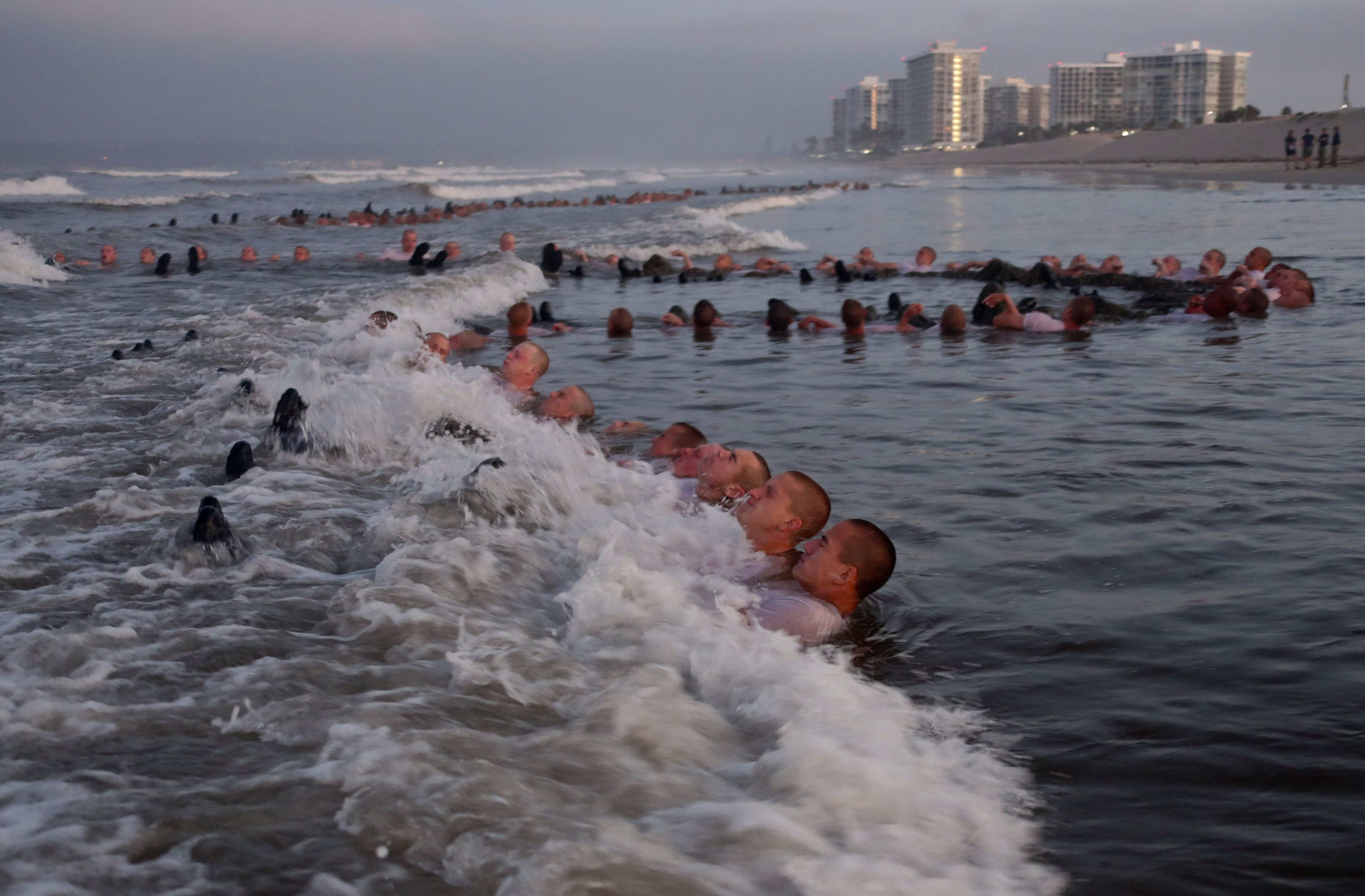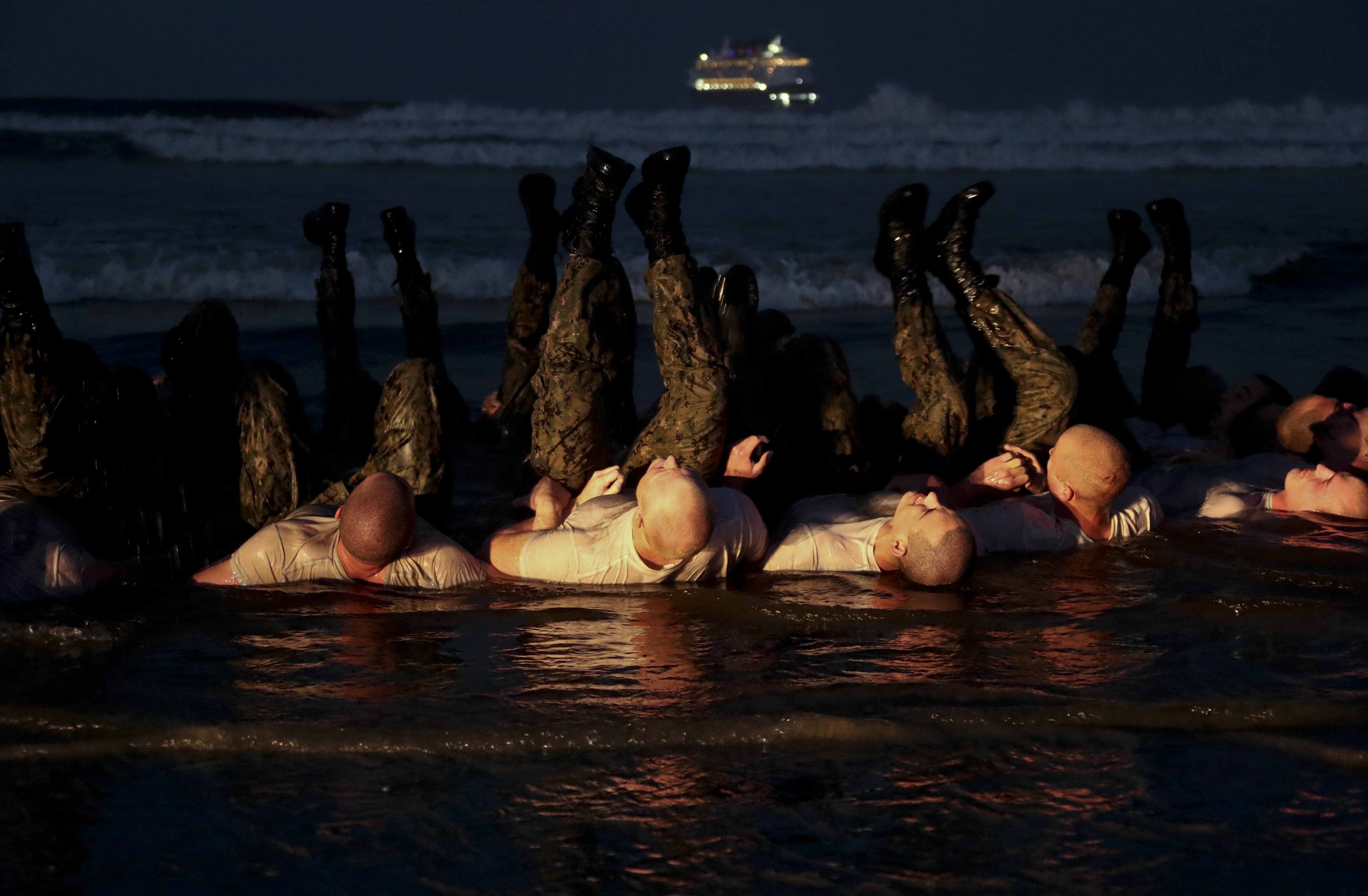
Naval Special Warfare Center is resuming its training of SEAL and special warfare combatant-craft crewmen (SWCC) candidates this week after taking a pause in March to ensure it could keep the coronavirus away from young recruits already putting their bodies through punishingly tough physical training courses.
Capt. Bart Randall, the commodore of NSW Center, told reporters today that all selection-and-assessment training will have restarted by next week – a decision supported in part by a new ability to test 100-percent of students and instructors for the COVID-19 virus, though other safety measures and practices are in place, too, to account for imperfect testing capabilities.
“Back in March I took this conservative approach to our training so we could properly assess naval special warfare’s student population here and establish the protocols in order to minimize the risk of COVID to our students and our staff,” he said, noting that senior non-commissioned officers who train new students were the ones who originally brought the concern to his attention.
“My decision in restarting training follows very careful planning that included implementing COVID-19 mitigation efforts that are based on [Centers for Disease Control and Prevention] recommendations and [Defense Department] guidance.”
This week the center resumed its Phase 1 of Basic Underwater Demolition/SEAL (BUD/S) training and its Basic Crewman Selection (BCS) training. Next week the SEALs’ Phase 2 training that centers around diving will also resume.
Randall said there have been zero cases of COVID-19 so far within his command’s infrastructure. The way the Navy has been conducting bubble-to-bubble transfers, there’s already a low risk of sick students showing up: new recruits are quarantined for 14 days before entering boot camp at Great Lakes, Ill.; they are then isolated at boot camp with instructors now living aboard the training facilities rather than going home at night; after boot camp, they attend a special warfare prep school at Great Lakes for eight weeks; and then they are transferred to NSW Center in Coronado, Calif., on clean military aircraft to maintain the virus-free “bubble” around them.
Once at SEAL and Special Boat training, students will undergo daily medical screenings, will only have contact with their small cohort of students, will get to-go meals from the mess to bring back to their own barracks, and will maintain social distancing in the classroom and during some physical training where possible. Instructors will wear masks and gloves where practical and will increase their use of megaphones to avoid face-to-face contact with students, Randall said.
But, ultimately, he said, the students within a cohort will be near each other.
“All of our SEAL and SWCC students will continue to train to the same high standards demanded of Naval Special Warfare operators, and their instruction will take place in an environment that promotes their safety, health and wellbeing,” he said.
“But the bottom line is, they’re going to have close contact. Right now, the students are on log [physical training] down at the beach. … We are not going to change the training that we’ve established here throughout the history of Naval Special Warfare because of this. We would rather delay training until COVID’s completely out, and that’s why I delayed training in March. I wasn’t sure we had everything in place to react. But now I am confident. So our students are close together. Members of a boat crew are like members of your family during training; and just as I go home to my wife and we lay in the same bed together, these guys are under a log together right now. It may not be the same, but it’s close. And I’m telling you, the goal here is that we keep it out of the ecosystem, and that’s where we’re focusing our energy.”

To that point, finding asymptomatic carriers of the virus becomes all the more important when close contact can’t be avoided. Randall said DoD had given NSW Center its own BioFire COVID-19 testing unit last week to obtain rapid results, but that test is only effective on symptomatic patients, and the center was only given a limited number of test kits. Rather than waste them on trying to test the entire population, NSW Center was able to join a DoD pilot program using the Curative-Korva testing capability based out of Los Angeles, which specializes in finding asymptomatic carriers.
“Testing is only part of it,” Randall said of his decision to resume training as usual, due to reliability concerns about the tests.
“As a commander, I try to make decisions based on certainty, and even some of the best tests only have 75-, 80-percent certainty. So when a guy tests out negative for COVID, I still got a 20-percent chance of getting it wrong? Those aren’t good odds in the Navy or in combat or in anything,” he continued.
“So in the end, I treat all the students who are at risk as potential COVID candidates, and we really want to isolate them from the population, and if they’re exhibiting symptoms pull them [from their training cohort] and get them healthy again.”
Compared to the average group of people, Randall said his SEAL and Special Boat trainees are particularly motivated to stay healthy and acknowledge their own responsibility in that effort.
“Each of our students are pretty motivated to make it through training, and the only way they’re going to make it through is if they remain healthy. And COVID is one of the risks to their health. And so they also personally have some to bear here on ensuring they follow all the guidelines of social distancing, hand washing, et cetera.”
To help them remain healthy, Randall said NSW Center took steps early on to procure cloth face masks for the staff, as well as an abundance of cleaning supplies. Noting all the manpower resident on the campus, Randall said the students were cleaning their common spaces regularly and that the staff was doing the same in their spaces.
Additionally, whereas the medical facility set up to treat training injuries as well as illnesses – Randall said many students come down with respiratory symptoms simply due to pushing their bodies so hard during training – in a common area right near the training grounds, a separate triage center has been set up for anyone exhibiting COVID-related symptoms.

By a bit of happenstance, the pressure to maintain throughput rates is minimal, whereas the services’ boot camps can see much greater effects from pausing training or slowing throughput with smaller classes. Randall said the Navy typically puts about 1,200 to 1,300 students a year through SEAL and SWCC training, expecting about 25 percent to pass and join the special warfare community. The pass rates have been higher over the last three years, he said, and the command was already taking steps to bring in fewer new special operators to avoid flooding operational units. This year he expects to bring about 900 students through training, and the pause in training will have no lasting effect on his ability to fill operational billets with new operators.
Randall said he was confident in the measures he put in place and was pleased to see zero cases of COVID-19 so far, but he made clear he would be watching testing results and medical screenings carefully and adjusting as needed.
“Priority for me is safety in training,” he said multiple times during the press call.





